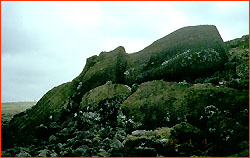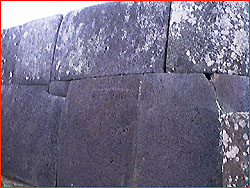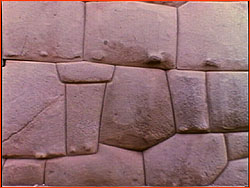 |
 |
 |
First Inhabitants by Liesl Clark 
 Ever since 1722, when Captain Jacob Roggeveen, a Dutchman and the first
European known to have reached Easter Island arrived, scholars have debated
the origins of the isolated population he found there. Did they sail from
the east, from South American soil, or from Central Polynesia to the north
and west? It is daunting to imagine a voyage to Easter Island from any
direction, which would have taken a minimum of two weeks, covering several
thousand miles of seemingly endless ocean. It is clear, however, that the
original inhabitants must have come from a sea-faring culture, adept at
building long-voyaging vessels and navigating the open seas.
Ever since 1722, when Captain Jacob Roggeveen, a Dutchman and the first
European known to have reached Easter Island arrived, scholars have debated
the origins of the isolated population he found there. Did they sail from
the east, from South American soil, or from Central Polynesia to the north
and west? It is daunting to imagine a voyage to Easter Island from any
direction, which would have taken a minimum of two weeks, covering several
thousand miles of seemingly endless ocean. It is clear, however, that the
original inhabitants must have come from a sea-faring culture, adept at
building long-voyaging vessels and navigating the open seas.
Linguists estimate Easter Island's first inhabitants arrived around AD 400, and most agree that they came from East Polynesia. The archaeological record suggests a somewhat later date of settlement, between AD 700 and 800. As early as BC 5500 people in Melanesia were voyaging in boats and trading in obsidian. The westward movement of people continued until Tahiti and the Marquesas Islands were reached, at least by AD 300. Voyaging canoes moved southward, northward and southeast to ultimately inhabit Easter Island, Hawaii, and New Zealand, all in the short period of about 400 years.  When Europeans first explored the Pacific and sailed from island to island,
they noticed that the people of various islands, no matter how distant, had
similar customs. Inhabitants looked similar in appearance and they were
often able to understand each other, even though they came from islands
thousands of miles apart. These linguistic links point to a genealogical
bond that ties the people of the Pacific to one another. Indeed, in 1994,
DNA from 12 Easter Island skeletons was found to be Polynesian.
When Europeans first explored the Pacific and sailed from island to island,
they noticed that the people of various islands, no matter how distant, had
similar customs. Inhabitants looked similar in appearance and they were
often able to understand each other, even though they came from islands
thousands of miles apart. These linguistic links point to a genealogical
bond that ties the people of the Pacific to one another. Indeed, in 1994,
DNA from 12 Easter Island skeletons was found to be Polynesian.
According to an Easter Island legend, some 1,500 years ago a Polynesian chief named Hotu Matu'a ("The Great Parent") sailed here in a double canoe from an unknown Polynesian island with his wife and extended family. He may have been a great navigator, looking for new lands for his people to inhabit, or he may have been fleeing a land rife with warfare. Early Polynesian settlers had many motivations for seeking new islands across perilous oceans. It's clear that they were willing to risk their lives to find undiscovered lands. Hotu Matu'a and his family landed on Easter Island at Anakena Beach. Te-Pito-te-Henua, "end of the land," or "land's end," is an early name for the island. On Rapa Nui, the more modern, and local, name for Easter Island, large palm forests flourished. Upon arrival, early Rapanui settlers would have planted the plants that they brought with them: banana trees, taro root, and perhaps even the sweet potato. Enigma of the Sweet Potato The existence of the sweet potato in Polynesia appears to leave open the question of who were the original inhabitants of Rapa Nui. Botanists have proven that the sweet potato originally came from South America. Does this mean that people from South America could have colonized the Pacific? According to Thor Heyerdahl, people from a pre-Inca society took to the seas from Peru and voyaged east to west, sailing in the prevailing westerly trade winds. He believes they may have been aided, in an El Niño year, when the course of the winds and currents may have hit Rapa Nui directly from South America. In 1947, Heyerdahl himself showed that it was possible, at least in theory; using a balsa raft named Kon Tiki, he drifted 4,300 nautical miles for three months and finally ran aground on a reef near the Polynesian island of Puka Puka.
Rapa Nui History From at least AD 1000 to 1680, Rapa Nui's population increased significantly. Some estimate the population reached a high of 9,000 by 1550. Moai carving and transport were in full swing from 1400 to 1600, just 122 years before first contact with European visitors to the island. In those 122 years, Rapa Nui underwent radical change. Core sampling from the island has revealed a slice of Rapa Nui history that speaks of deforestation, soil depletion, and erosion. From this devastating ecological scenario it is not hard to imagine the resulting overpopulation, food shortages, and ultimate collapse of Rapa Nui society. Evidence of cannibalism at that time is present on the island, though very scant. Van Tilburg cautiously asserts, "The archaeological evidence for cannibalism is present on a few sites.  Analysis of this evidence is only preliminary in most cases, making it
premature to comment on the scope and intensity of the practice as a
cultural phenomenon." Most scholars point to the cultural drive to complete
the colossal stone projects on Rapa Nui as the key cause of depletion of
the island's resources. But it wasn't the only one. Palm forests
disappeared, cleared for agriculture as well as for moving moai. Van
Tilburg comments, "The price they paid for the way they chose to articulate
their spiritual and political ideas was an island world which came to be,
in many ways, but a shadow of its former natural self."
Analysis of this evidence is only preliminary in most cases, making it
premature to comment on the scope and intensity of the practice as a
cultural phenomenon." Most scholars point to the cultural drive to complete
the colossal stone projects on Rapa Nui as the key cause of depletion of
the island's resources. But it wasn't the only one. Palm forests
disappeared, cleared for agriculture as well as for moving moai. Van
Tilburg comments, "The price they paid for the way they chose to articulate
their spiritual and political ideas was an island world which came to be,
in many ways, but a shadow of its former natural self."
The world that the Europeans first observed when they arrived on Rapa Nui in 1722 has puzzled us for centuries. What was the meaning of the massive stone human statues on the island? How did they transport and erect these multi-ton statues? And, finally, how did the original inhabitants arrive on this remote island? First Inhabitants | Ancient Navigation | Stone Giants | First Contact Photo: (1,3) © Michael Barnes, NOVA; (2) © Mark E. Gibson/Visuals Unlimited Move a Megalith | Dispatches | Explore the Island | Lost Civilization Resources | E-mail | Table of Contents | Easter Island Home Editor's Picks | Previous Sites | Join Us/E-mail | TV/Web Schedule About NOVA | Teachers | Site Map | Shop | Jobs | Search | To print PBS Online | NOVA Online | WGBH © | Updated November 2000 |

